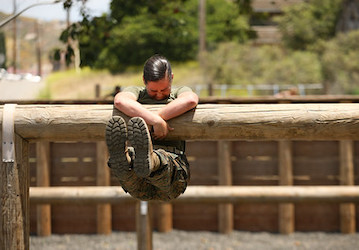Muscular endurance is your ability to hold a position for a long time—or to push, pull, or lift an object many times. Muscular strength is the ability of a muscle to exert a maximal or near maximal force against an object—or how much weight you can push, pull, or lift. Muscular endurance is an important component of physical and military fitness, especially when you’re doing repetitive tasks with heavy loads. Some evidence shows that low muscular endurance is a risk factor for injury, so improving your strength might help reduce your risk.
It’s important to design an enjoyable workout program that will help you reach your muscular endurance goals. If you’re new to resistance training on your own, be sure to talk with a strength and conditioning professional, USMC Force Fitness Instructor, or Army Master Fitness Trainer for guidance on how to develop and perform your routine.
Assess your strength
Before starting a program, assess your current level of muscular strength (with a partner for safety) using the 1-repetition maximum or 1RM test. If you choose to lift weights to build endurance, you’ll need to lift a certain percentage of your 1RM, so it’ll be good to know what yours is. From there, you can design a program that will properly build muscular endurance.
Follow the FITT principle
When you start training to improve muscular endurance, bodyweight exercises such as squats and push-ups will work well. Eventually, as your strength and endurance improve, you’ll need to use heavier weights to continue making progress. As you design your program, follow the FITT principle—consider the Frequency, Intensity, Time, and Type of your workouts.
Frequency is the number of sessions in a week you train. You should do resistance training at least 2 days a week.
Intensity is the amount of weight you use per repetition (rep). For muscular endurance, include at least 12 reps of less than 67% of your 1RM per set, and 2–4 sets, in your training workouts. Beginners typically start with 8–10 reps, then progress each week by keeping the weight the same but adding 1–2 reps a week until reaching about 16 reps.
Time your sessions to range from 30–60 minutes, including proper work:rest ratios. For muscular endurance, use a work:rest ratio of about 1:1. For example, if it takes you 30 seconds to do a set of 12 reps, then rest for about 30 seconds before you start your next set. The National Strength and Conditioning Association recommends limiting rest to a maximum of 30 seconds between sets, even if the work period takes a bit longer. Limiting rest allows your body less time to recover, which is how you train to build muscular endurance.
Type of exercise should vary in both your strength and conditioning routines to improve gains and keep you engaged in your workouts.
To progress over time, increase any one or more of the FITT components. Change your training routine gradually, avoiding large increases in any single component to reduce your risk of injury. The changes for muscular endurance are a bit different than what you’d make for muscular strength. For endurance, the intensity (weight) stays the same, and you increase the number of reps, rather than increasing the intensity and decreasing the number of reps as you would for muscular strength. Learn more about designing a long-term program and progressing to new goals with a block-periodized workout plan.
Try different types of endurance training
Bodyweight exercises are great, especially for beginners. These exercises improve stability and strength by using just your body weight (without the use of additional weights) for resistance. Other types of equipment, such as suspension straps, can be added to increase the intensity of these types of exercises. However, suspension training might require more skill and instruction if you’ve never done this type of workout before.
Free weights such as barbells or dumbbells are available in most fitness centers. You can also buy them at most sports stores. Using free weights for strength training can improve your stability and identify strength imbalances between your left and right sides. When using free weights, form is critical. Take a look at HPRC’s tips on foundational movements to learn how to do different types of lifts safely and effectively. The video below shows one of the squat variations, and there are several videos for each of the different movements. If you don’t have easy access to free weights, you can get creative. Use household items such as milk cartons or bottles filled with rocks, sand, or water.
Machine weights are popular for resistance training and available in most gyms. These machines isolate certain muscles for the activity each machine is built for. For example, a leg-extension machine can help isolate and strengthen your quadriceps muscle group (quads). Machines are generally a safe way to resistance train, and they’re good for beginners. The downside of machines is that the strengthening isn’t functional, meaning doing leg extensions won’t be as effective at making you functionally stronger for things such as your job duties. When you do use machines, make sure they’re set up properly for your body to optimize the exercises.
Plan and track your resistance training
These days, apps for just about any type of workout can show you how to do specific exercises and might even have preprogrammed workouts you can follow. The U.S. Army Training and Doctrine Command’s (TRADOC) “Army PRT” app has the PRT workout program. The Navy Fitness website has several apps for specific training types under the Navy Operational Fitness and Fueling System (NOFFS) program as well. Or use HPRC’s weight-training planner if you prefer to write things down instead.
Every Service branch’s physical fitness (PF) test includes a test for muscular endurance (maximum reps) in a set period of time. Learn more about the various fitness tests:
